KENYA
History

History

History
Nomads, Farmers and Settlers
According to paleontologists such as the famous Richard Leakey, the Rift Valley, which also runs through Kenya, is the "cradle of mankind". In any case, one of the skulls found in the area around Lake Turkana is about 2.5 million years old, and comes from the so-called "homo habilis". Approx. 4000 years ago Kenya was inhabited by the Khoisan who were related to southern African peoples. After that, Kenya became a migration country par excellence, partly due to the fertile soil in this part of Africa. For example, practically all major languages of Africa are spoken in Kenya.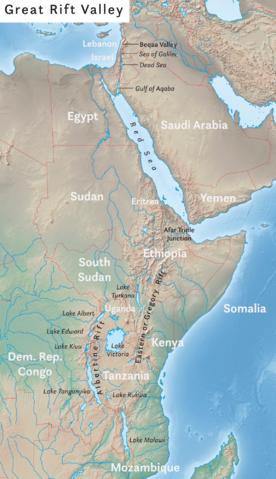 Great Rift Valley runs through KenyaPhoto: Redgeographics CC 4.0 Internationa no changes made
Great Rift Valley runs through KenyaPhoto: Redgeographics CC 4.0 Internationa no changes made
The first group of migrants was the nomadic Kushite people of Ethiopia around 2000 BC. They were herders and therefore dependent on pasture for their cattle and goats. After climate changes that had a negative impact on the landscape, these people moved south towards Tanzania. A second group, East Kushites, succeeded this group around 1000 BC. and settled in Central Kenya. The rest of the many tribes and peoples arrived between 500 BC. and 500 AD: Bantu-speaking peoples like the Gusii, Kikuyu, Akamba and Meru from West Africa and Nilotic-speaking peoples like the Maasai, Luo, Samburu and Turkana from the Nile Valley into Southern Sudan.
Portuguese rule
From the 8th century, the coastal region of Kenya was visited by Muslims of the Arabian Peninsula. They did not intend to conquer the area but mainly traded there. Many settled permanently and mixed with the African population.
This created a series of coastal cities along the East African coast from Somalia to Mozambique, often used as goods depots where ships for the Indian trade routes were supplied. While there was inevitably rivalry between these cities, it was a fairly peaceful area until the 16th century. All this was cruelly disrupted by the arrival of the Portuguese explorers and traders. While the Spaniards moved towards America, the Portuguese tried to tighten their grip on the spice routes to the Far East.
In 1498, a Portuguese expedition led by Vasco da Gama rounded the Cape of Good Hope in South Africa and sailed on to the east coast of Africa. They were received with great hostility there, but were lucky to find a sultan in Malindi who showed them the routes to India. In 1502 Vasco da Gama came back again with another expedition.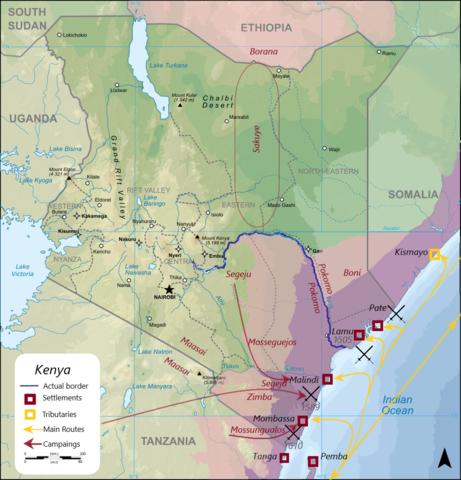 Portuguese presence in Kenya from the 15th to the 17th centuryPhoto: Hugo Refachinho CC 4.0 International no changes made
Portuguese presence in Kenya from the 15th to the 17th centuryPhoto: Hugo Refachinho CC 4.0 International no changes made
From 1505, the ferocious attacks of the Portuguese armada of Dom Francisco de Almeida began. Sofala was looted and burned to the ground, Kilwa was occupied and Mombasa was taken after bombardments from the ships and street fighting. Mombasa was sacked again in 1528 by Nuña da Cunha.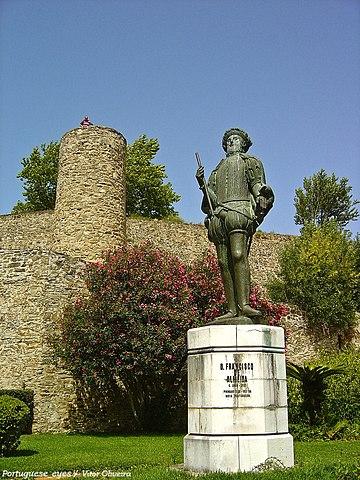 Statue of Dom Francisco de Almeida, KenyaPhoto: Vitor Oliveira from Torres Vedras PORTUGAL CC 2.0 Generic no changes made
Statue of Dom Francisco de Almeida, KenyaPhoto: Vitor Oliveira from Torres Vedras PORTUGAL CC 2.0 Generic no changes made
Despite attempts by the Ottoman Turks in 1585 and 1589 to regain control of the area, the Arab monopoly on the Indian trade routes had finally come to an end. After this violent time, two centuries of strict colonial rule began for Kenya. Fees were levied and all non-Portuguese ships had to pay a lot of money to be able to moor in the ports. Minor offenses were heavily fined.
This economic exploitation went hand in hand with the conversion of the population to Catholicism, at least an attempt to do so, because this did not really work. Fort Jesus was built in 1593, making Mombasa the main Portuguese outpost. Still, the Portuguese could not keep these and other outposts under control, partly because they had to be supplied from Goa in West India. This did not always work for various reasons (storms, pirates). Moreover, it soon became apparent that Portugal was too small a country to rule such a huge world empire. The end of Portuguese rule in East Africa was fast approaching when the Arabs took Fort Jesus in 1698. Around 1720 the Portuguese would leave the east coast of Kenya for good.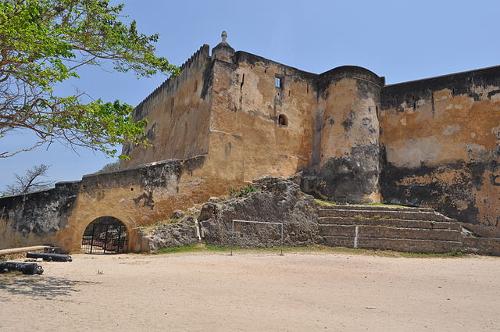 Fort Jesus, Mombasa, KenyaPhoto: Alex Wafula CC 3.0 Unported no changes made
Fort Jesus, Mombasa, KenyaPhoto: Alex Wafula CC 3.0 Unported no changes made
Arab rule
The Arabs continued to maintain control of the East African coast until the British and Germans arrived in the late 19th century. However, the devastation of the Portuguese period had taken a heavy toll and the constant bickering between the Arab governors led to a decline in trade and prosperity. During the 18th century several dynasties from Oman settled along the east coast of Africa. Although they were in principle under the control of the Sultan of Oman, in practice not much of it came to fruition and it was not until the regime of Seyyid Said in 1805.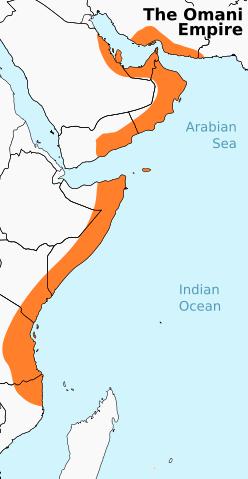 The Empire of Oman around the middle of the 19th centuryPhoto: ArnoldPlaton CC 3.0 Unported no changes made
The Empire of Oman around the middle of the 19th centuryPhoto: ArnoldPlaton CC 3.0 Unported no changes made
The Omanites had built up a fairly strong fleet and with this Seyyid Said got the East African dynasties in line. In 1822 he sent an army to subdue the important cities of Mombasa, Paté and Pemba, which at that time were ruled by the Mazrui clan. The Mazrui called on the British, who immediately sent two warships. The British took Fort Jesus without any problems, hoisted the British flag and declared the fort a British protectorate. Three years later, the British government rejected the protectorate and a year later the fort was occupied by Seyyid Said again. From there, clove plantations were established on the island of Zanzibar off the Tanzanian coast, and in 1832 he even moved the capital to Zanzibar.
British colonization
In the mid-19th century, the various European nations, including the British and the Germans, became increasingly interested in the East African coast. The British were interested because of the abolition of slavery and soon established a consulate on Zanzibar. Later, the two countries agreed (Treaty of Heligoland) that Great Britain would gain control of Kenya, Zanzibar and Uganda. In return, Germany received the previously British Heligoland with Denmark and present-day Tanzania. The boundaries that were established at that time still largely exist. Part of the agreement was that the Sultan of Zanzibar was allowed to keep a 16 kilometer wide stretch of coast under a British protectorate. This agreement remained valid until Kenya's independence, when the last sultan of Zanzibar, Seyyid Khalifa, returned the land to the Kenyan government.
The interior of Kenya, especially the Rift Valley and the Aberdare mountain area, remained untouched by Europeans until the eighties of the nineteenth century. The Maasai's warlike reputation was enough to keep European missionaries and Arab slaves away from their home. But it could not last long, because by that time all of Africa had already been almost traversed by explorers, biologists, archaeologists, anthropologists and adventurers. Some well-known names of the time were the German Gustav Fischer, the Scot Joseph Thomson, the Austrian Count Teleki von Szek and the Anglican Bishop James Hannington. By the end of the 19th century, however, the Maasai tribe's strength had been weakened by a war between two tribes and diseases that affected both humans and animals.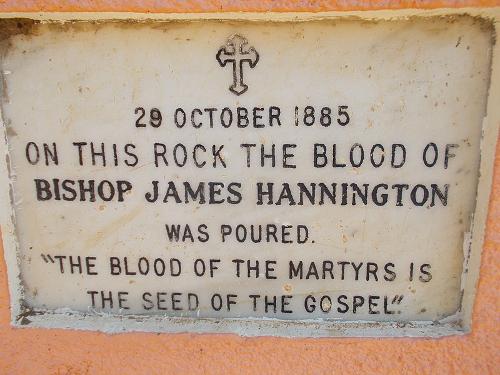 James Hannington was murdered on October 29, 1885 in Busoga, UgandaPhoto: Asiimwe Raymondo CC 4.0 International no changes made
James Hannington was murdered on October 29, 1885 in Busoga, UgandaPhoto: Asiimwe Raymondo CC 4.0 International no changes made
The British could now negotiate more easily with Olonana, the "laibon" (kind of spiritual leader). Armed with this agreement, the British immediately started construction of the Mombasa-Uganda railway line, right through the heart of Maasai land. The capital Nairobi is now located halfway along the railway line, where the colonial administration soon moved from Mombasa. White settlers looked for fertile farmland north of Nairobi. Clashes between settlers and Maasai were inevitable and in consultation with Olonana, the Maasai were allotted two plots of land, north and south of the railway.
However, the British settlers soon turned their eye to the land north of the railway line and the Maasai were forced to move to the southern part in 1910-1911, under protest from Olonana. Often they also had no choice but to enter the service of the white farmers. The Kikuyu tribe also suffered greatly from the loss of land to the British colonists. Resistance was almost impossible given the military superiority of the Europeans. Other large tribes like the Luo and Luyha and tribes in the Northeast were hardly bothered. The white settlers were led by the political leader Lord Delamere, who, however, knew little about the land, the diseases and the animal life. The extensive rearing of sheep and grain cultivation was therefore disastrous for the landscape. In the meantime, Great Britain moved government again from Zanzibar to Mombasa, and from there to Nairobi in 1907. From 1912, a somewhat more realistic, more varied agricultural policy was maintained, including coffee plantations.
During World War I, two-thirds of the 3,000 settlers were called into arms and deployed as cavalrymen against the Germans in Tanganyika. They even managed to drive the Germans off to Central Africa. After the war, colonization was resumed and by 1920 the number of settlers had increased to 9,000; in 1950 to 80,000. War veterans from Europe, for example, were offered land at predatory prices. In 1920, Kenya officially became a British Crown Colony. Only the coastline remained in the possession of the Sultan of Zanzibar.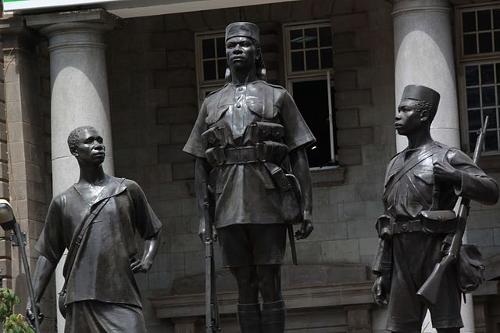 Monument WWI in Nairobi, KenyaPhoto: U249601 CC 4.0 International no changes made
Monument WWI in Nairobi, KenyaPhoto: U249601 CC 4.0 International no changes made
Meanwhile, more and more Kikuyus migrated to Nairobi or got involved in the colonial economy in some way. Dissatisfaction also grew about taking their land just like that and a number of organizations arose with the aim of returning the expropriated land to the Kikuyus. One of the first leaders, Harry Thuku, was arrested in 1922 for his political activities for the banned East African Association. Then a group of Africans went to the Nairobi police station where Thuku was imprisoned. Nobody knew what had happened afterwards, but when the powder fumes cleared, at least 21 Kikuyus had been killed. Other reports spoke of a hundred deaths. Thuku was not released until 1930 after promising to cooperate with the British authorities. From then on he was considered a collaborator by the Kikuyus.
Jomo Kenyatta
Another star in the Kikuyu firmament was Johnstone Kamau, later known as Jomo Kenyatta. He moved to Nairobi at the age of 29 and soon became the propaganda secretary of the East Africa Association because of his great oratory talents. This organization was created to bring about land reforms, increase wages, and improve education and medical facilities for the African population. At that time, the African population had the lowest paid jobs and, for example, was not allowed to enter certain hotels and restaurants. It was already officially determined in 1923 that the interests of the Africans had to be always respected but in practice, of course, it did not work that way.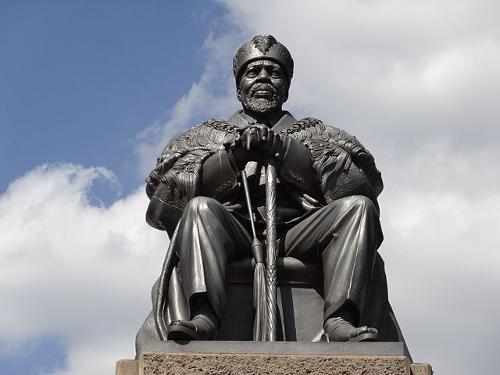 Statue of Jomo Kenyatta, KenyaPhoto: K.Gituma CC 3.0 Unported no changes made
Statue of Jomo Kenyatta, KenyaPhoto: K.Gituma CC 3.0 Unported no changes made
Kenyatta noticed this and joined the more fanatical Kikuyu Central Association and became its secretary general. From 1929 to 1946, Kenyatta traveled around the world, gathering ideas that would later come in handy for his country. When he finally returned to Kenya in 1946, he became the undisputed leader of the Kenyan independence movement. During World War II, all colonial powers recruited African troops to fight in Europe. An unintended side effect of their experiences in the army was that they saw that the Europeans were not all powerful, that they could be defeated. In addition, they were now trained in the use of modern weapons. When the African soldiers returned, they used this knowledge to take an active part in all kinds of campaigns aimed at change.
The main political organization at the time was the Kenya African Union (KAU), led first by Harry Thuku, then by James Gichuru, who resigned in favor of Jomo Kenyatta after his return from Britain.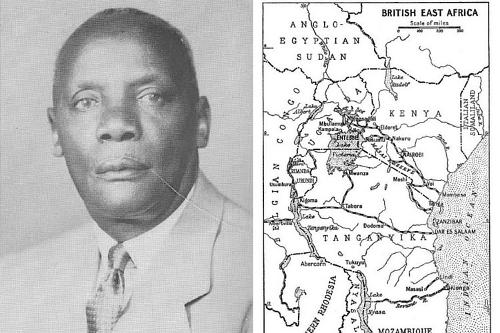 Harry Thuku (1895 – 14 June 1970) was a Kenyan politician, one of the pioneers in the development of modern African nationalism in KenyaPhoto: Editor CC 4.0 International no changes made
Harry Thuku (1895 – 14 June 1970) was a Kenyan politician, one of the pioneers in the development of modern African nationalism in KenyaPhoto: Editor CC 4.0 International no changes made
However, the wishes of the KAU were hardly listened to and as a result secret societies arose within many tribes. The best-known society would be the Mau Mau movement, founded in 1952, consisting entirely of Kikuyus and whose goal was to drive the settlers from Kenya. In 1953, the Mau Mau started the rebellion with the killing of a herd of animals belonging to a white farmer. A few weeks later, 21 British Kikuyus were murdered. The government declared a state of emergency and began trapping Kikuyu in so-called "protected villages" surrounded by barbed wire and booby-trapped ditches. Furthermore, about 20,000 Kikuyus were recruited to help the British suppress the revolt. The rebellion ended in 1956 with more than 13,500 dead on the side of the Africans, and just over 100 on the side of the Europeans. Another 20,000 Kikuyus were captured and many more died in appalling conditions. Kenyatta was arrested as early as 1953 as the alleged leader of the Mau Mau movement, something he probably never was. In 1956 the Africans first talked to resolve the political conflict. In 1957, eight more Africans were allowed to represent their peoples in parliament. Among them the young activist Daniel arap Moi, who would later become president of Kenya.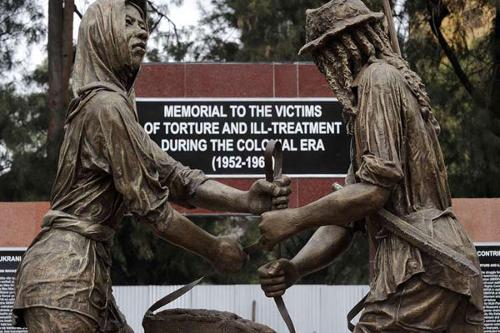 Memorial in honour of victims of torture in Kenya during the British colonial eraPhoto: U249601 CC 4.0 International no changes made
Memorial in honour of victims of torture in Kenya during the British colonial eraPhoto: U249601 CC 4.0 International no changes made
Kenyatta was released in 1959 but immediately placed under house arrest. The rebellion shocked the settlers and led to the establishment of several white political parties and the departure of many settlers to Rhodesia (now Zimbabwe), South Africa and Australia. A number of parties wanted to split the country into white and black Kenya. Other parties wanted democratic elections, and that was to be adopted as the course to follow at the 1960 Lancaster House Conference. The date for independence was set for a day in December 1963, and the Kenyan government even received $ 100 million to buy out white farmers. Meanwhile, the KAU had split into a movement that advocated a centrally-led government in Nairobi (KANU = Kenya African NationalUnion) and a movement that opted for a federal state to prevent Kikuyu force majeure (KADU = Kenya African Democratic Union). Most whites, of course, supported the KADU. In 1961 Kenyatta was released and elected chairman of the KANU. He tried to reassure the settlers, they would have nothing to fear in an independent Kenya that would desperately need their experience. He wanted to show the world that two completely different cultures could coexist peacefully. And so, in the eyes of the settlers, Kenyatta turned from a dreaded Mau Mau leader into a respected statesman.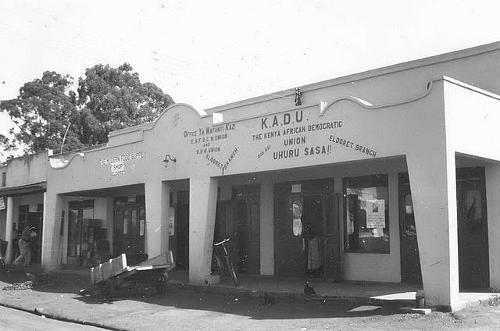 Building of the Kenya African Democratic Union (KADU)Photo: Martin Dixon CC 2.0 Generic no changes made
Building of the Kenya African Democratic Union (KADU)Photo: Martin Dixon CC 2.0 Generic no changes made
The two sides formed a coalition government in 1962, but after the first general election in May 1963, KANU and Kenyatta came to power as the first prime minister. At that point, Kenya took control of all internal affairs. Defense and foreign affairs remained in the hands of the British. On December 12, 1963, Kenya became fully independent with Kenyatta as its first president.
In 1964, Kenya became virtually a one-party state as KADU disbanded. Kenya also got a parliament with only one chamber. In 1966 an opposition party was founded one more time by the Luo Oginga Odinga. Odinga ended up in prison several times after conspiracy theories against the government.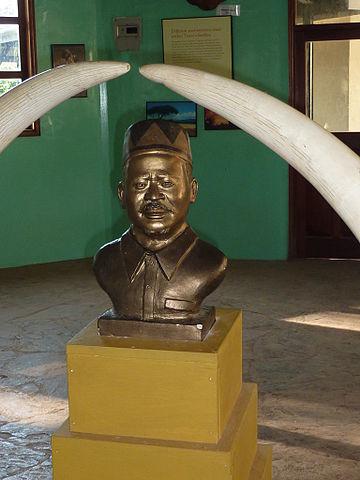 Buste of Jaramogi Oginga Odinga, KenyaPhoto: Ngompol CC 3.0 Unported no changes made
Buste of Jaramogi Oginga Odinga, KenyaPhoto: Ngompol CC 3.0 Unported no changes made
Tom Mboya, also a Luo and seen as a future presidential candidate, was shot dead in 1969 by a Kikuyu. Also J.N. Kariuki, a very popular Kikuyu who spoke out fanatically about the new black elite and the associated corruption, was murdered in 1975. Other opponents of Kenyatta were also regularly arrested and held for long periods without trial.
The period after Kenyatta
Kenya's first president Jomo Kenyatta passed away on August 12, 1978. Kenyatta was succeeded by Kenyatta's vice president Daniel arap Moi, a member of the Tugen tribe. He declared war on corruption and cronyism and declared amnesty for all prisoners, but his reign was marked in the early years by the arrests of dissidents, the dissolution of tribal groups and the closure of several universities. This often happened after alleged conspiracy theories against the government. In any case, criticism of Moi and his government was absolutely not tolerated. In August 1982 a coup attempt by the Kenyan Air Force followed, supported by students from Nairobi University. The coup was crushed by pro-government troops and about 120 people were killed. Twelve leaders were sentenced to death and 900 others were sentenced to prison terms. The entire air force was replaced by new units. After this first coup attempt, more would have followed, but details were never disclosed.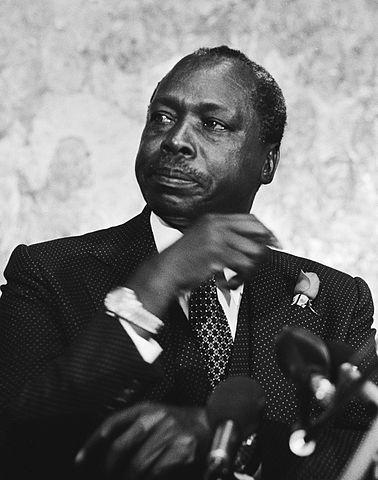 Daniel Toroitich arap Moi was President of Kenya from 1978 to the end of 2002 Photo: Croes, Rob C. / Anefo CC 3.0 Netherlands no changes made
Daniel Toroitich arap Moi was President of Kenya from 1978 to the end of 2002 Photo: Croes, Rob C. / Anefo CC 3.0 Netherlands no changes made
President Moi was re-elected in March 1987 through a highly controversial voting system. After the election, Moi appointed as many as 33 ministers and several key opposition politicians were silenced after allegations of ballot box falsification. In addition, Moi significantly expanded presidential power by granting himself the right to appoint or dismiss judges and high-ranking officials at will. From that time on, the political opposition was effectively silenced. The KANU strengthened its powerful position through the KANU Youth Wing, the party's youth wing, which, however, was also used to disrupt demonstrations and harass or even intimidate opposition figures. Opposition leaders such as Mwai Kibaki and Kenneth Matiba were also imprisoned without trial. The opposition now had to come from the ecclesiastical side. Several Kenyan spiritual leaders from Christian churches have been very critical of Moi's government. However, they too were threatened with imprisonment and prosecution.
But times would change; multiparty systems were spreading all over Africa and Kenya would not escape this. After the collapse of communism in Eastern Europe and the disintegration of the Soviet Union, the West drew attention to Africa, among other things. Until then, many corrupt totalitarian regimes had been supported as long as they did not show communist sympathies. The Kenyan government soon felt pressured by a number of donor countries to implement a multiparty system and set an election date as soon as possible, otherwise the financial aid would be stopped. To achieve this quickly, all aid was temporarily suspended at the beginning of 1992 and the government was forced to cooperate.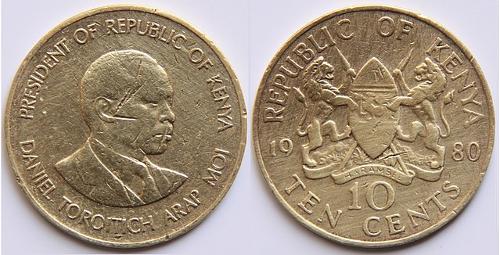 Coin depicting Daniel arap Moi from 1980 Photo: AKS.9955 CC 4.0 International no changes made
Coin depicting Daniel arap Moi from 1980 Photo: AKS.9955 CC 4.0 International no changes made
The opposition, united in the FORD (Forum for the Restoration of Democracy), seemed to win the upcoming elections. But the opposition killed itself. The three leaders, Odinga, Matiba and Kibaki, wanted to become president of Kenya themselves. Therefore they split the FORD into FORD-Kenya with Odinga, FORD-Asili with Matiba and the Democratic Party with Kibaki. At that point, the chance of an election win was actually gone. Meanwhile, Moi printed $ 250 million in Kenyan shillings that were not backed by gold reserves. This money was given to the population, 500 Ksh each. Although Moi knew the economy would collapse because of this move, it was enough to get a lot of votes in the elections. The tribes class was also completely over again. He allowed his native Kalenjin tribe to instigate fights against Kikuyu farmers. Hundreds were killed and wounded in these fighting and thousands were driven from. He also tried to hold the elections on a weekday in the last week of December. As a result, tens of thousands of voters, especially in Nairobi and other major cities, would not be able to vote because they had to vote in the place where they were registered. International observers were only flown in a few days in advance.
The elections themselves were fairly fair, but the damage had long been done by then. Moi and the KANU won the election with only a third of the vote. If the opposition had stayed united, they would certainly have won. After the election, several members of parliament defected from the opposition to the KANU. The press talked about voter fraud and that the KANU would have paid money for this, but in the end could not prove anything. THE KANU had little to fear from the opposition, which in turn was very divided on who would become the opposition leader.
A new opposition party was founded in 1995. The Safina, founded by white paleontologist Richard Leakey, Raila Odinga and Paul Muite sought to bring together the fragmented opposition. President Moi saw danger and refused to register the party. Leakey was intimidated for weeks. Moi even made statements that the whites had no business in politics and should only worry about their economic activities. In 1996, the KANU proposed to change the constitution so that Moi could serve one more term as president.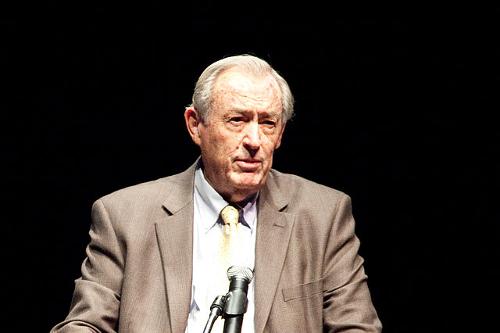 Richard Erskine Frere Leakey is a Kenyan paleoanthropologist, conservationist and politicianPhoto: Ed Schipul CC 2.0 Generic no changes made
Richard Erskine Frere Leakey is a Kenyan paleoanthropologist, conservationist and politicianPhoto: Ed Schipul CC 2.0 Generic no changes made
In July and August 1997 there was again a lot of political-ethnic violence in Nairobi and on the coast, with dozens dead and hundreds injured. President Moi, who was reelected in December 1997, subsequently allowed limited reforms. In the parliamentary elections, where ethnic factors played an important role, the ruling party KANU won a small majority. In the first months of 1998, more than a hundred people were killed in riots. On August 7, 1998, Kenya was very negative in the international news. A heavy bomb exploded at the US Embassy in Nairobi, causing an adjacent office building to collapse. More than 250 people were killed and about 5,000 were injured. The suspicion, including for the simultaneous attack on the American embassy in the Tanzanian capital Dar es-Salaam, focused on a fundamentalist Islamic group led by the Saudi Osama bin Laden.
In August, Pakistan extradited a Palestinian suspect, Mohammed Saddiq Odeh. He disclosed the evidence to the FBI in Nairobi. Odeh is said to have prepared the attack with a Saudis and an Egyptians. There was a lot of criticism of the actions of US Marines after the explosion, who gave priority to American victims in the relief efforts. But a little later, the Kenyan population welcomed American retaliatory actions in Sudan and Afghanistan. President Moi signed a law in 1998 providing for a constitutional reform. Moi preferred to have the constitutional revisions handled by parliament, in which his party, the KANU, has the majority. Incidentally, the parliament unanimously voted in favor of a law limiting the power of the president.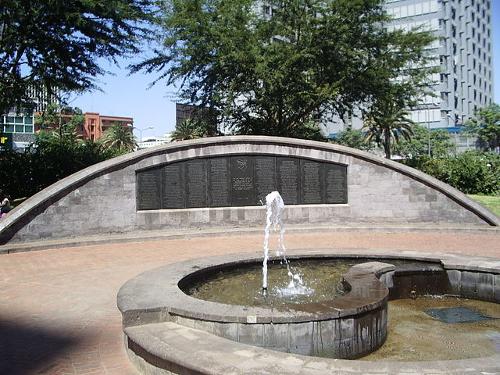 Memorial on the occasion of the bombing of the American embassy in Nairobi, Kenya Photo: Zweifel CC 3.0 Unported no changes made
Memorial on the occasion of the bombing of the American embassy in Nairobi, Kenya Photo: Zweifel CC 3.0 Unported no changes made
Kenya had problems on all its borders in 1999. Sudan reverted to its claim to the Ilemi Triangle, which was under Kenyan control at the time. Conflicts in Somalia and between the Ethiopian Army and the Oromo Liberation Front were sometimes fought on Kenyan territory. Kenya took an international turn when agents of the Turkish secret service kidnapped the Kurdish leader Öcalan in Nairobi and brought it back to Turkey.
At the end of December 2002, Mwai Kibaki, from the Kikuyu tribe, was named the new president of Kenya. He defeated government candidate Uhuru Kenyatta, son of President Kenyatta, who died in 1978, by a wide margin. In parliament, the 12-party National Rainbow Coalition of 71-year-old Kibaki took over power from KANU, the party of outgoing Daniel arap Moi, who had been president from 1978. The KANU had to sit in the opposition benches after 39 years.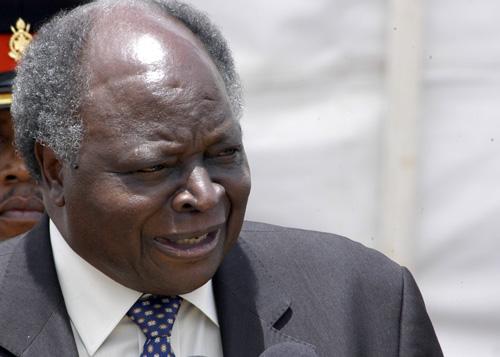 Mwai Emilio Stanley Kibaki was the third president of KenyaPhoto: DEMOSH CC 2.0 Generic no changes made
Mwai Emilio Stanley Kibaki was the third president of KenyaPhoto: DEMOSH CC 2.0 Generic no changes made
The new president and government inherit from the previous Moi government a country characterized by mismanagement and socio-economic failures. The Kenyans hoped to see changes that would lead to an increase in prosperity and well-being. To be successful in this, the government would have to face poverty, unemployment, crime, corruption and poorly implemented policies and governance. However, the government has had several consecutive defeats with the negative outcome of the referendum on the reform of the constitution and then with the major corruption scandals that became known in January 2006. After the referendum 'no', Kibaki fired the entire cabinet. However, there was no succession, so some key ministers took up office again. After 5 months of recess, the Kenyan Parliament restarted in March 2006. In addition, a major corruption scandal was presented in January 2006 in a report by John Githongo, which implied that some ministers were involved in corruption in state contracts. Kibaki claims victory in the December 2007 presidential elections. The opposition led by Odinga wins the most seats in the parliamentary elections. In February, Ban Ki-moon, the president of the UN, mediates between the parties.
In April 2008, Kibaki and Odinga agree on the division of posts in a new cabinet. In July 2009, the Kenyan government announced that there will be no special tribunal for election violence. In August 2009, Hillary Clinton visited Kenya and criticized the country for its lack of research into election violence. In October 2009, the government pledged its cooperation in the international criminal court's investigation into election violence. In July 2010, Kenya and its neighbors form an East African common market.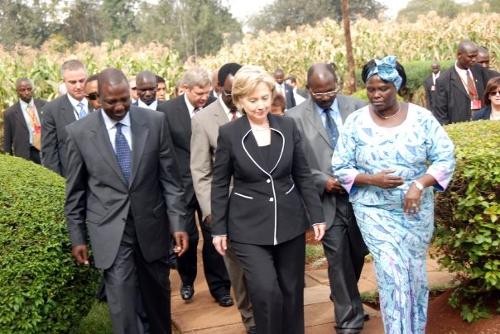 U.S. Secretary of State Hillary Clinton (center) walks with Kenyan Minister of Agriculture William Ruto (left) and Kenyan environmental and political activist Wangari Maathai (right)Photo: America.gov CC 2.0 Generic no changes made
U.S. Secretary of State Hillary Clinton (center) walks with Kenyan Minister of Agriculture William Ruto (left) and Kenyan environmental and political activist Wangari Maathai (right)Photo: America.gov CC 2.0 Generic no changes made
In April 2013 Uhuru Kenyatta is elected 4th President of Kenya. In September 2013, an attack on a Nairobi shopping center claimed by al-Shabab militants from Somalia. Various attacks were also committed in 2014. A low point came in April 2015 when all Shabab attacked Garissa University and killed 148 people. In July 2015, President Obama of the United States visits Kenya, his father's country of birth. He praises the progress that the country has made, but calls attention to improving the situation of gays.
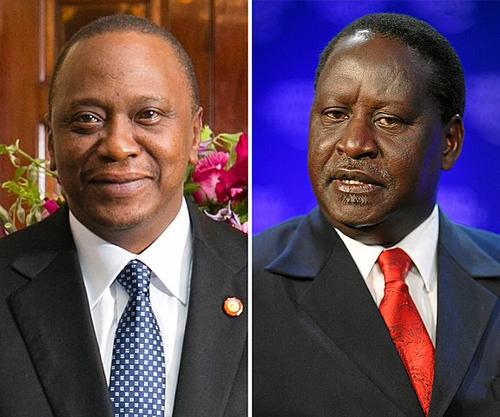 Uhuru Kenyatta en Raila Odinga, KenyaPhoto: Amanda Lucidon (Uhuru Kenyatta photograph) / World Economic Forum (Raila Odinga photograph) CC 2.0 Generic no changes made
Uhuru Kenyatta en Raila Odinga, KenyaPhoto: Amanda Lucidon (Uhuru Kenyatta photograph) / World Economic Forum (Raila Odinga photograph) CC 2.0 Generic no changes made
In October 2017, President Kenyatta will be declared the winner of the presidential election. In January 2020, Al-Shabab Islamic militia attacks. Next elections are to beheld in August 2022.
Sources
Dietz, T. / Kenya : mensen, politiek, economie, cultuur
Koninklijk Instituut voor de Tropen / Novib
Finlay, H. / Kenya
Lonely Planet
Kenia
Het Spectrum,
Winslow, Z. / Kenya
Chelsea House Publishers
CIA - World Factbook
BBC - Country Profiles
Copyright: Team The World of Info